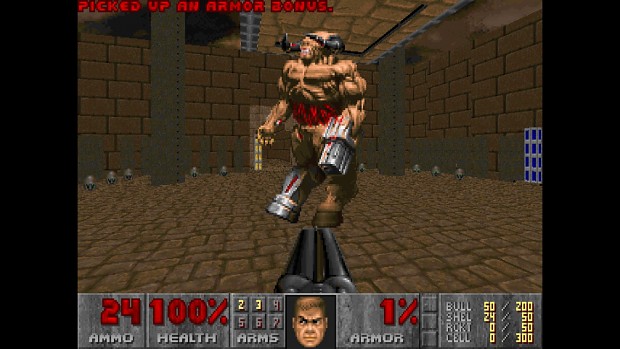
The image file must be in one of the supported image file formats. If an external resource is used as the detail texture, its dimensions must be powers of two (for example 128×64 or 256×256). When using the -file option to load detail texture lumps, the file names of the images become lump names. A signed-add blending is used, which lets the detail texture either darken or brighten the underlying texture: black ⇒ darker, gray ⇒ no change, white ⇒ brighter.ĭetail textures can be assigned to specific wall textures and flats using Detail definitions.ĭetail textures can be loaded from external image resources (from the Textures directory), or PCX images and raw image data stored inside a WAD lump. special colors indicate transparent pixels).ĭetail textures are grayscale images that are rendered on top of normal textures when walls and planes are viewed from close by. The -ck suffix makes the image color keyed (i.e. For example: playa1-table01-ck.png would be the Doom player sprite frame A1 with color table 1. Doom and Heretic have 4 tables, Hexen has 8. tableNum is the index number of the color translation table. In Hexen, it's the player's class (0=Fighter, 1=Cleric, 2=Mage). This number is always zero in Doom and Heretic. (classNum) is the number of the color translation class. (patchName) is the sprite frame lump name. (patchName)-table(classNum)(tableNum).ext To indicate that a resource is color-mapped, its name is formed like this: However, color-mapped versions of sprite frames can each have their own external resources. Doomsday will not change colors on the fly in external resources. Otherwise the size and/or aspect ratio will not be right for the resource.įor example, in order to replace the Doom medikit (lump name MEDIA0), one would place the file media0.png into the Patches directory.ĭoom uses color-mapping to change specific colors in some sprites, e.g., the players, so that the same image can be displayed with different coloring without having multiple copies of it in memory. This means the external resources must really be high-resolution versions of the original images. The same restrictions apply, though: the dimensions of the external resource do not affect the actual size of the sprite frame. They can be replaced with external resources just like all other patches. Both cyan (0,255,255) and purple (255,0,255) are used as keys, and will be replaced with transparent pixels. Color keying is applied if the file name of the image ends in “-ck”, for example brnbigc-ck.png. This means TGA/PNG textures whose width and height are already powers of two can be loaded faster.Ĭolor keying allows having transparent pixels in an image format that has no alpha channel. Note that the engine will have to resize all textures so that their dimensions are powers of two (e.g. This means the aspect ratio of the new texture doesn't have to be the same as of the original texture. The engine will render them scaled so that they fit the size of the original texture. High-resolution textures can be of any size. Since the palette doesn't have to be the same as the game's, it should be enough for many textures.

It is the easiest format in which to distribute the textures due to its small size. The recommended format for high-resolution textures is paletted PNG. wadtool is available in the Doomsday source repository under /tools/wadtool.ģ2-bit images are just 24-bit images with an additional 8 bits per pixel for the alpha channel. When writing the DD_DIREC table, the prefix “/data/jdoom/textures/” would be added to each file name. This would create a WAD file that contains all the files from the current directory. Wadtool myfiles.wad /data/jdoom/textures/
Doomsday hi res intermission screen plus#
Skyjake has created a simple utility for automatically creating a WAD file that contains the current directory and all its subdirectories plus a DD_DIREC lump that has (with a high probability) a unique lump name for each file. Note, however, that all kinds of files are not loaded using the DD_DIRECs: for instance demos (which are compressed with the LZSS library) must always be loaded from real files. The engine will first search the DD_DIRECs before opening any file for reading. The paths that begin with a (back)slash are interpreted as paths that start from the Doomsday base directory (set with -basedir) and paths that don't begin with a (back)slash are located in the runtime directory. An example is shown below:Įach line in DD_DIREC contains a lump/path pair. It contains a table that translates file paths to lump names. Another special lump used by Doomsday is DD_DIREC.


 0 kommentar(er)
0 kommentar(er)
